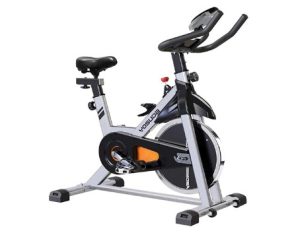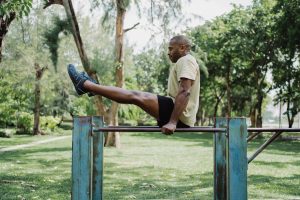
The Jefferson Curl Stretch, a dynamic exercise that targets the flexibility and mobility of the spine and posterior chain, has gained popularity in the fitness world for its numerous benefits. This article delves into the origins, technique, benefits, and safety considerations associated with the Jefferson Curl Stretch, providing readers with comprehensive insights to make informed decisions about incorporating it into their fitness routines.
- Importance of Jefferson Curl Stretch Daily Life:
- Brief Overview of the Jefferson Curl Stretch:
- Jefferson Curl Stretch Benefits:
- Potential for Reducing Lower Back Pain and Discomfort:
- How To Do Jefferson Curl Stretch Properly:
- Precautions and Safety Considerations:
- How To Incorporate the Jefferson Curl into Your Fitness Routine:
- Conclusion:
Importance of Jefferson Curl Stretch Daily Life:
The Jefferson Curl Stretch finds its roots in gymnastics and weightlifting communities. It involves flexing the spine while holding a barbell or other weighted object, moving from a standing position to a forward bend, and then returning to an upright position. This sequence of movements effectively stretches the hamstrings, lower back, and upper back, promoting greater flexibility and range of motion in these areas.
By focusing on the posterior chain, which includes the hamstrings, glutes, and back muscles, the Jefferson Curl Stretch contributes to improved strength and stability in these crucial areas. As a result, individuals who regularly perform this exercise may experience enhanced athletic performance and reduced risk of injuries related to weak or tight muscles in the back and legs.
Aside from its muscular benefits, the Jefferson Curl Stretch also plays a role in enhancing posture and spinal alignment. As individuals practice the controlled forward bend, they engage the core muscles, leading to improved core strength and posture. Over time, this exercise may help alleviate lower back pain and discomfort, as it helps lengthen and decompress the spine.
Proper technique is essential when performing the Jefferson Curl Stretch to ensure its safety and effectiveness. To execute the stretch correctly, individuals must maintain a slow and controlled movement pattern, paying attention to their breath and never forcing the body beyond its limits. Furthermore, it is crucial to warm up adequately before attempting the Jefferson Curl Stretch, as it involves intense stretching of the spine and hamstrings.
Although the Jefferson Curl Stretch offers numerous benefits, it is not suitable for everyone. Individuals with pre-existing spinal or lower back issues should exercise caution or avoid the stretch altogether. Additionally, novices or those unfamiliar with the exercise should seek guidance from fitness professionals to ensure they are performing it correctly and safely.
To incorporate the Jefferson Curl Stretch into a fitness routine, individuals should consider adding it to their warm-up or cool-down routines. It pairs well with exercises that focus on hip mobility and core strength, such as yoga poses and stability exercises. The frequency and duration of the stretch should be adapted to the individual’s fitness level, gradually increasing as flexibility and strength improve.
Expert advice from fitness professionals and experienced practitioners can offer valuable insights into optimizing the benefits of the Jefferson Curl Stretch. Addressing common misconceptions and concerns about the exercise can also help dispel any fears and encourage safe and mindful practice.
Brief Overview of the Jefferson Curl Stretch:
The Jefferson Curl Stretch is a unique exercise with a fascinating history that traces back to both gymnastics and weightlifting communities. Its origins can be attributed to the renowned American weightlifter, Paul Anderson, who popularized the movement in the mid-20th century. Anderson was known for his incredible strength and flexibility, and he used the Jefferson Curl to enhance his lifting performance and maintain spinal health.
Biomechanically, the Jefferson Curl Stretch involves a controlled flexion of the spine while holding a barbell or weighted object. The movement starts from a standing position, and the individual slowly initiates the forward bend from the top of the spine, sequentially curling the vertebrae one by one until the entire spine is rounded. The weighted load facilitates a gentle stretch on the hamstrings, lower back, and upper back as the individual moves into the forward bend.
During the movement, the muscles of the posterior chain are the primary focus. These muscles include the hamstrings, glutes, erector spinae, and other smaller back muscles. As the spine is rounded and lengthened, the hamstrings are thoroughly stretched, which contributes to increased flexibility in this muscle group. Simultaneously, the back muscles are engaged to support and control the movement, leading to improved strength and stability in the entire posterior chain.
Furthermore, the Jefferson Curl Stretch significantly impacts the areas of the body directly connected to the spine. As the spine is sequentially flexed, the exercise promotes spinal mobility and flexibility. The movement involves a decompression of the intervertebral discs, which may alleviate pressure on the spine, potentially reducing lower back discomfort.
The controlled nature of the Jefferson Curl Stretch allows individuals to focus on individual segments of the spine, offering a unique opportunity for targeted stretching and strengthening. As a result, the exercise can be particularly beneficial for those seeking to improve their posture, as it helps activate and strengthen the core muscles responsible for maintaining an upright position.
In summary, the Jefferson Curl Stretch has a rich history rooted in strength and flexibility training. Its biomechanics involve controlled flexion of the spine with the support of a weighted load, leading to increased flexibility in the hamstrings and enhanced strength and stability in the posterior chain. By targeting the spine and its connected muscles, this exercise contributes to improved posture and may aid in reducing lower back discomfort. Understanding the origins, mechanics, and targeted muscle groups of the Jefferson Curl Stretch empowers individuals to incorporate it safely and effectively into their fitness routines.

Jefferson Curl Stretch Benefits:
The Jefferson Curl Stretch offers a range of benefits that make it a valuable addition to any fitness routine. By regularly incorporating this exercise, individuals can experience the following advantages:
1. Improved Flexibility and Range of Motion:
One of the primary benefits of the Jefferson Curl Stretch is its significant impact on flexibility. As the spine is sequentially flexed during the movement, it helps lengthen and stretch the hamstrings, promoting greater flexibility in these muscles. Moreover, the controlled and gradual nature of the stretch allows individuals to work on specific segments of the spine, gradually increasing their range of motion over time. Improved flexibility not only enhances athletic performance but also contributes to better overall mobility in daily activities.
2. Increased Strength and Stability of the Posterior Chain:
The Jefferson Curl Stretch effectively targets the muscles of the posterior chain, which include the hamstrings, glutes, and lower back muscles. As individuals engage in the forward bend, the posterior chain muscles are activated and strengthened to support and control the movement. This enhanced strength not only aids in performing the stretch but also carries over into other physical activities, such as lifting, running, and sports. A strong and stable posterior chain is essential for maintaining proper posture and preventing injuries.
3. Enhancing Posture and Spinal Alignment:
Consistent practice of the Jefferson Curl Stretch contributes to improved posture and spinal alignment. As the exercise engages the core muscles and promotes spinal flexibility, it encourages proper alignment of the spine, reducing the likelihood of slouching or rounding of the back. Strengthening the core muscles also plays a vital role in maintaining an upright posture, which is essential for spinal health and overall well-being.
Potential for Reducing Lower Back Pain and Discomfort:
Individuals who experience lower back pain and discomfort may find relief through the Jefferson Curl Stretch. By gently decompressing the spine and promoting flexibility in the hamstrings and back muscles, the exercise can alleviate pressure on the lower back. Moreover, the improved spinal alignment and strengthened core muscles can help distribute the load more evenly throughout the spine, reducing the strain on specific areas and alleviating pain.
It is essential to note that while the Jefferson Curl Stretch offers numerous benefits, it may not be suitable for everyone. Individuals with pre-existing spinal or lower back issues should exercise caution and consult with a healthcare professional or fitness expert before attempting the stretch. Furthermore, it is crucial to perform the exercise with proper technique and avoid overstretching to prevent injury. With mindful practice and appropriate guidance, individuals can enjoy the advantages of the Jefferson Curl Stretch and support their overall flexibility, strength, and spinal health.
How To Do Jefferson Curl Stretch Properly:
Performing the Jefferson Curl Stretch with the correct technique is crucial to ensure its effectiveness and safety. Below are the step-by-step instructions for the stretch, common variations and modifications, and the role of proper breathing during the exercise:
1. Step-by-step instructions for the Jefferson Curl Stretch:
- Stand with your feet shoulder-width apart and position the barbell in front of you, starting with a light weight or no weight at all for beginners.
- Engage your core muscles to stabilize your spine and maintain a neutral position.
- Begin the movement by initiating a slow and controlled forward bend from the top of your spine (cervical region). Gradually flex your neck, followed by your upper back (thoracic spine), middle back (lumbar spine), and finally your lower back (sacral spine).
- Imagine your spine curling one vertebra at a time, as if you were rolling down a string from the top of your head to the base of your spine.
- Keep your knees slightly bent throughout the movement to reduce stress on the hamstrings and lower back.
- Continue the forward bend until you reach your maximum range of motion or until you feel a gentle stretch in the hamstrings and back. Avoid forcing the movement or overstretching.
- Hold the bottom position briefly, maintaining tension in the core and back muscles.
- To return to the starting position, reverse the movement by gradually uncurling your spine from the bottom up, engaging your back muscles and core for control.
- Stand back up to the starting position, ensuring a slow and controlled motion throughout the entire process.

2. Common variations and modifications based on individual abilities:
- Weight Progression: Beginners should start with a light barbell or no weight at all. As flexibility and strength improve, gradually increase the weight.
- Partial Range: For individuals with limited flexibility or mobility, performing the Jefferson Curl Stretch over a smaller range of motion can be more manageable and safe.
- Using a Resistance Band: Instead of a barbell, a resistance band can be utilized, anchored at waist level, to provide a gentler stretch while maintaining proper form.
3. The role of proper breathing during the Jefferson Curl Stretch:
- Inhale: Take a deep breath before starting the movement. Inhale as you initiate the forward bend and continue to breathe slowly and deeply throughout the entire stretch.
- Exhale: Exhale as you reach the bottom position of the stretch. This helps activate the core muscles and promotes stability during the movement.
- Inhale during Return: Inhale as you slowly reverse the movement and return to the starting position. Focus on maintaining control and proper form while breathing.
By following these step-by-step instructions, considering appropriate variations, and practicing proper breathing techniques, individuals can safely and effectively perform the Jefferson Curl Stretch to improve their flexibility, strength, and overall spinal health. Remember to start with lighter weights and consult with a fitness professional if you have any concerns or existing health conditions.
Precautions and Safety Considerations:
The Jefferson Curl Stretch can be a beneficial exercise, but certain precautions and safety considerations should be taken into account to prevent injuries and ensure a safe practice. Here are some important points to consider:
1. Not Suitable for Everyone:
While the Jefferson Curl Stretch can be beneficial for many individuals, it may not be suitable for everyone, especially those with specific health conditions or concerns. Individuals with existing spinal issues, such as herniated discs, spondylolisthesis, or spinal stenosis, should avoid this stretch, as it may exacerbate their condition. Pregnant women and individuals with high blood pressure should also refrain from attempting the Jefferson Curl, as it involves forward bending and increased intra-abdominal pressure. If you have any health concerns or uncertainties, it is essential to consult with a healthcare professional or a qualified fitness expert before attempting this exercise.
2. Importance of Warming Up:
Warming up before attempting the Jefferson Curl Stretch is essential to prepare the body for the movement. Engaging in a dynamic warm-up that includes light cardiovascular exercises, mobility drills, and gentle stretching can help increase blood flow to the muscles, improve flexibility, and reduce the risk of injury. A well-prepared body is more receptive to the stretch and less prone to strain or overexertion.
3. Using Proper Form:
Proper form is crucial during the Jefferson Curl Stretch to avoid undue stress on the spine and minimize the risk of injury. Perform the movement with a slow and controlled pace, ensuring each vertebra is sequentially engaged during the forward bend and uncurled during the return to the starting position. Avoid rounding the back too aggressively or forcefully, as this can strain the discs and soft tissues of the spine. Keep the core engaged throughout the exercise to support the spine and maintain stability.
4. Listening to the Body:
It is vital to listen to your body and be mindful of any discomfort or pain during the Jefferson Curl Stretch. If you experience sharp or intense pain, stop the exercise immediately and seek guidance from a fitness professional or healthcare provider. Never force the body into a position that feels uncomfortable or causes pain. Be patient and gradually progress with the stretch, allowing your body time to adapt to the movement.
Avoid overstretching, especially if you are a beginner or have limited flexibility. Respect your body’s limits and work within a range of motion that feels comfortable and controlled. Overstretching can lead to muscle strains, joint injuries, and other complications, so it is essential to practice the Jefferson Curl Stretch with caution and respect for your body’s capabilities.
How To Incorporate the Jefferson Curl into Your Fitness Routine:
The Jefferson Curl Stretch can be a valuable addition to a well-rounded fitness routine. Here’s how to effectively incorporate it into your workouts:
1. Integrating the Stretch into a Warm-up or Cool-down Routine:
- Warm-up: Start your warm-up with five to ten minutes of light cardiovascular activity, such as brisk walking or jogging, to increase blood flow and raise your body temperature. Follow this with mobility exercises that focus on the spine and hamstrings, such as cat-cow stretches and leg swings. After the mobility work, perform a few sets of bodyweight squats and gentle forward bends to prepare your body for the Jefferson Curl Stretch.
- Cool-down: After your main workout, include the Jefferson Curl Stretch in your cool-down routine. This will help lengthen the muscles worked during the workout and promote flexibility. Gradually lower the intensity of your workout, and then proceed with the Jefferson Curl Stretch following the step-by-step instructions mentioned earlier. Finish the cool-down with static stretching for other major muscle groups.
2. Complementary Exercises to Enhance Benefits:
- Yoga Poses: Incorporate yoga poses such as Downward Dog, Forward Fold, and Seated Forward Bend to further enhance flexibility in the hamstrings and spine.
- Core Strengthening Exercises: Work on core strength with exercises like planks, bridges, and supermans to provide better support for the spine during the Jefferson Curl Stretch.
- Hip Mobility Drills: Include exercises like hip circles and hip flexor stretches to complement the stretch’s effect on the posterior chain and promote better overall mobility.
3. Frequency and Duration Recommendations:
- Frequency: The frequency of performing the Jefferson Curl Stretch depends on your fitness level and flexibility. Beginners may start with two to three sessions per week, while more experienced individuals can aim for three to five sessions. Allow at least one day of rest between sessions to give your muscles time to recover.
- Duration: Each session of the Jefferson Curl Stretch can last anywhere from 5 to 10 minutes, depending on your fitness level and comfort. Start with shorter durations and gradually increase the time as you gain more experience and flexibility. During each stretch, perform 5 to 10 repetitions, focusing on smooth and controlled movements.
It is essential to listen to your body and avoid pushing yourself too hard when incorporating the Jefferson Curl Stretch into your fitness routine. Be patient and consistent with your practice, as improvements in flexibility and strength may take time. If you are new to this exercise, consider seeking guidance from a fitness professional to ensure proper form and safety.
Remember that individual results may vary, and what works for one person may not be suitable for another. Always consult with a healthcare professional or qualified fitness expert if you have any concerns or pre-existing health conditions before integrating the Jefferson Curl Stretch into your fitness routine. With proper guidance and mindful practice, you can harness the benefits of this stretch and support your overall flexibility and spinal health.
Conclusion:
In conclusion, the Jefferson Curl Stretch is a dynamic exercise with a rich history that offers a multitude of benefits for those seeking to improve flexibility, strength, and spinal health. Its origins in weightlifting and gymnastics have led to its recognition as an effective movement to target the posterior chain, increase range of motion, and promote better posture. However, it is essential to approach the Jefferson Curl Stretch with caution and mindfulness, as it may not be suitable for everyone, especially those with specific health conditions.
By incorporating the Jefferson Curl Stretch into a warm-up or cool-down routine, individuals can enhance its effectiveness and ensure proper preparation and recovery for the body. This stretch can be complemented with other exercises, such as yoga poses and core strengthening drills, to promote overall flexibility and stability. Listening to the body, using proper form, and avoiding overstretching are essential considerations to reduce the risk of injuries and optimize the stretch’s benefits.
For those looking to include the Jefferson Curl Stretch in their fitness routine, gradual progression and consistency are key. Starting with lighter weights and shorter durations can help build the foundation for safe and effective practice. Consulting with fitness professionals and experts can provide valuable guidance and personalized recommendations.
Ultimately, the Jefferson Curl Stretch can be a valuable tool in fostering better flexibility, strength, and spinal alignment, empowering individuals to achieve their fitness goals and support overall well-being. By understanding its origins, mechanics, and targeted muscle groups, individuals can approach this exercise with confidence, knowing they are incorporating a safe and beneficial stretch into their fitness journey.




